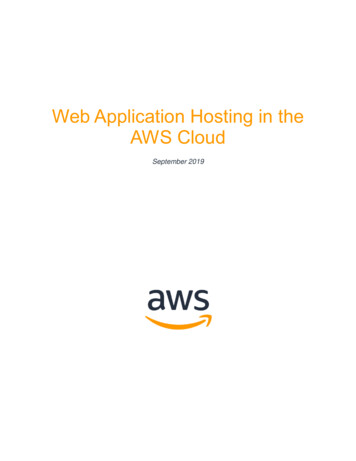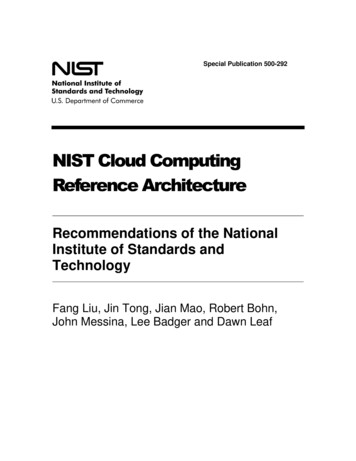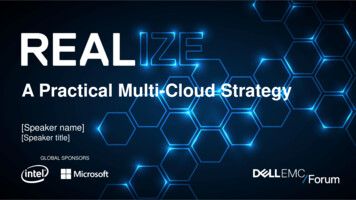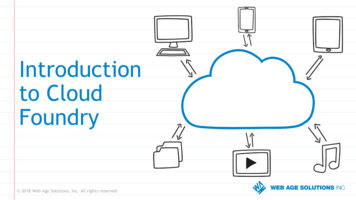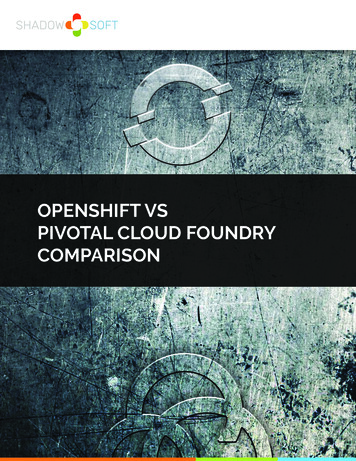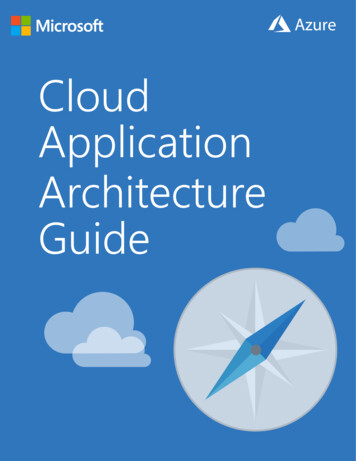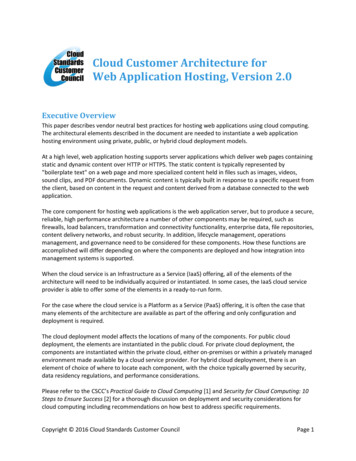
Transcription
Cloud Customer Architecture forWeb Application Hosting, Version 2.0Executive OverviewThis paper describes vendor neutral best practices for hosting web applications using cloud computing.The architectural elements described in the document are needed to instantiate a web applicationhosting environment using private, public, or hybrid cloud deployment models.At a high level, web application hosting supports server applications which deliver web pages containingstatic and dynamic content over HTTP or HTTPS. The static content is typically represented by"boilerplate text" on a web page and more specialized content held in files such as images, videos,sound clips, and PDF documents. Dynamic content is typically built in response to a specific request fromthe client, based on content in the request and content derived from a database connected to the webapplication.The core component for hosting web applications is the web application server, but to produce a secure,reliable, high performance architecture a number of other components may be required, such asfirewalls, load balancers, transformation and connectivity functionality, enterprise data, file repositories,content delivery networks, and robust security. In addition, lifecycle management, operationsmanagement, and governance need to be considered for these components. How these functions areaccomplished will differ depending on where the components are deployed and how integration intomanagement systems is supported.When the cloud service is an Infrastructure as a Service (IaaS) offering, all of the elements of thearchitecture will need to be individually acquired or instantiated. In some cases, the IaaS cloud serviceprovider is able to offer some of the elements in a ready-to-run form.For the case where the cloud service is a Platform as a Service (PaaS) offering, it is often the case thatmany elements of the architecture are available as part of the offering and only configuration anddeployment is required.The cloud deployment model affects the locations of many of the components. For public clouddeployment, the elements are instantiated in the public cloud. For private cloud deployment, thecomponents are instantiated within the private cloud, either on-premises or within a privately managedenvironment made available by a cloud service provider. For hybrid cloud deployment, there is anelement of choice of where to locate each component, with the choice typically governed by security,data residency regulations, and performance considerations.Please refer to the CSCC’s Practical Guide to Cloud Computing [1] and Security for Cloud Computing: 10Steps to Ensure Success [2] for a thorough discussion on deployment and security considerations forcloud computing including recommendations on how best to address specific requirements.Copyright 2016 Cloud Standards Customer CouncilPage 1
Figure 1: Web Application Hosting Cloud ArchitectureWeb application hosting is ubiquitous in the computing world and represents a generic pattern that canbe applied in many situations. Cloud computing and cloud services are often considered for bothexisting and new web application hosting environments. This is in part driven by the frequency that webapplications are required. It also occurs because cloud elasticity and scalability naturally lends itself tothe needs of a web application hosting environment.The following section describes the various components in detail.Copyright 2016 Cloud Standards Customer CouncilPage 2
ComponentsPublic Network ComponentsUser – Users can interact with the web application from a variety of devices and systems.Edge Services – Edge services include network service capabilities needed to deliver content to webapplications and its users through the Internet. These include: DNS Server – The Domain Name System (DNS) server maps the text URL(domain name) for a particular web resource to the TCP-IP address of thesystem or service that can deliver that resource to the client.Content Delivery Network (CDN) – Content Delivery Networks aregeographically distributed systems of servers deployed to minimize theresponse time for serving resources to geographically distributed users,ensuring that content is highly available and is provided to users withminimum latency. Which servers are engaged will depend on server proximityto the user and where the content is stored or cached.Firewall – A Firewall is a system designed to control communication access to or from a system,aiming to permit only traffic meeting a set of policies or rules to proceed and blocking any trafficthat does not meet these policies. Firewalls can be implemented as separate dedicatedhardware, or as a component in other networking hardware such as a load-balancer or router oras integral software to an operating system.Load Balancer – Load Balancers distribute network or application traffic across many resources(such as computers, processors, storage, or network links) to maximize throughput, minimizeresponse time, increase capacity, and increase reliability of applications. Load balancers canbalance loads locally and globally. Considerations should be made to ensure that thiscomponent is highly available and is not a single point of failure.Cloud Provider Network ComponentsWeb Service TierThe provider cloud can host the web services tier which contains the program logic used to generatedynamic web content. This can involve retrieval of data from files, databases, HTTP-services, sensors,and other sources of data as well as programmatic generation of new data or information. Web serversand application servers can also be instantiated in a 3-tiered setup with separated, rather thanintegrated, web servers and application servers. In that case, there would be separate pools of webservers and application servers connected via load balancers. The applicationserver would be responsible for accessing databases or other systems.Components include: Web Application Servers – Web Application Servers offer web serverfunctionality and integrated application server functionality if it is needed.Web servers are systems that return resources (web content and images,for example) in response to an HTTP request and may be configured tohandle requests for multiple IP addresses and/or domains. WebCopyright 2016 Cloud Standards Customer CouncilPage 3
application servers may support clustering, pooling, and other high availability and scalingconfigurations including auto scaling – instantiating and removing application server instancesas demand requires.Cache – Caches store information temporarily needed to fulfill a request by the web applicationserver, including session data and other content. The purpose of the cache is to reduce thelatency in responding to a request from a client.File Repository – File repositories are devices or applications that store information, data, etc. inthe form of files. Access to the file repository generally includes the ability to store, retrieve,delete, and search the repository for a particular file. File repositories can use network storageto provide access to shared files.User Directory – User Directory contains user IDs and credentials needed to validate that theuser is allowed to access the information or applications being requested in the Web serversand application servers. The directory can be accessed by web servers, applications servers,databases or any other elements used in the web application.API Management – API management capabilities advertise the available servicesendpoints to which the application has access. It provides API discovery, catalogs,and connection of offered APIs to service implementations and managementcapabilities, such as API versioning. APIs and services are the contemporaryfoundation for transformation and much connectivity. The design and operation ofthese services should address eight key elements to assure a solid foundation for areliable transformation and connectivity strategy: composition, security,deployment, access, governance, analytics, management, and scalability. API Discovery/Documentation – Provides the ability for mobile developers to find anduse APIs securely.Management – Provides a management view into API usage by web applications andmobile apps using information from mobile gateway, backend, etc.Transformation and Connectivity – The enterprise transformation andconnectivity component enables secure connection to enterprise systems and theability to filter, aggregate, or modify data or its format as it moves between webcomponents (systems of engagement) and enterprise systems (typically, systemsof record). Within the web application reference architecture, the transformationand connectivity component sits between the web and enterprise tiers. However,in a hybrid model, these lines might become blurred. The elements that comprisethis architecture domain, listed below, were until very recently listed as separatetool types: Enterprise Application Integration (EAI), Data Integration (DI) andExtract, Transform, and Load (ETL). The Transformation and Connectivitycomponent includes the following capabilities: Enterprise Secure Connectivity – Leverages security services to integrate with enterprise datasecurity to authenticate and authorize access to enterprise systems.Transformation – Transforms data between enterprise systems.Copyright 2016 Cloud Standards Customer CouncilPage 4
Enterprise Data Connectivity – Provides the ability for mobile components to connect securelyto enterprise data. Examples include VPN and gateway tunnels.Enterprise Network ComponentsWithin enterprise networks, enterprises typically host a number of applications that deliver criticalbusiness solutions along with supporting infrastructure like data storage. Typically, applications will havesources of data that are extracted and integrated with services provided by the cloud service provider.Analysis is performed in the cloud computing environment, with output consumed by on-premisesapplications. Any data from enterprise applications can be sent to enterprise or departmental systemsof record represented by the enterprise data components. Systems of record data have generallymatured over time and are highly trusted.Service TierEnterprise User Directory – Provides storage for and access to user information to supportauthentication, authorization, or profile data. Security services and edge services use this to manageaccess to the enterprise network, enterprise services, or enterprise specific cloud provider services.Enterprise Data – Enterprise Data includes metadata about the data as well as systemsof record for enterprise applications. Because of compliance requirements for localizeddata storage, the use of distributed database management tools that accommodatehybrid cloud architectures is essential to handling global user bases. Many types ofenterprise data play a role in a web application hosting design. These include: Reference Data – Reference data provides the standard context for collecteddata. In some instances, Reference Data and Master Data are one in the same.Master Data – These repositories can be updated with the output ofapplications, enterprise applications, and analytics to assist with subsequentdata transformation, enrichment, and correlation.Transactional Data – Data about or from business interactions that adhere to asequence or related processes (such as financial, logistical, or other process).This data can come from reference data, master data repositories, and distributed data storage.Application Data – Data used by or produced by business solutions and enterprise applicationsfunctionally or operationally. Frequently the data has been improved or augmented to add valueand drive insight.Log Data – Data aggregated from log files from enterprise applications, sensors, infrastructure,security, governance, and service providers.Enterprise Content Data – Data, frequently object files, to support any enterprise applicationsor B2B or B2C content delivery on a large scale.Historical Data – Data from past analytics and enterprise applications and systems. Use of cloudbased storage for archived data reduces storage costs and expedites use of analytics as a serviceand mining data for new insights.Enterprise Applications – Enterprise applications can consume cloud provider data and analytics toproduce results that address business goals and objectives. Enterprise applications can be updated fromCopyright 2016 Cloud Standards Customer CouncilPage 5
enterprise data or the web applications, or they can provide input and content for enterprise data orweb applications. Applications might include: Customer Experience – Customer-facing cloud systems can be a primarysystem of engagement that drives new business and helps service existingclients with lower initial cost.New Business Models – Alternative business models that focus on low cost,fast response, and great interactions are all examples of opportunitiesdriven by cloud solutions.Financial Performance – The office of finance should become more efficientas data is consolidated and reported faster and easier than in the past.Risk – Having more data available across a wider domain means that riskanalytics are more effective. Elastic resource management means moreprocessing power is available in times of heightened threat.IT Economics – IT operations are streamlined as capital expenditures arereduced while performance and features are improved by cloud deployments.Operations and Fraud – Cloud solutions can provide faster access to more data allowing formore accurate analytics that flag suspicious activity and offer remediation in a timely manner.Security ComponentsSecurity for web application hosting addresses fundamental business needs of security such as: Right people having access to the cloud web applications and their data (Confidentiality) The data of business users are intact and not tampered (Integrity) Availability / uptime of cloud web applications despite many security threats (Availability) Help address industry and regulatory compliance needs (Compliance)Security capabilities to address business needs include:Identity & Access Management – Capabilities to identify and authorize theuser providing role-based access to cloud web applications. It also enablessingle sign-on, user lifecycle management, and audit logging. The user typesand their levels of access for cloud web applications need to be managed.This could include business users (customer, vendor, 3rd party, staff users),or IT users (administrators, privileged users, application users). Identity andaccess management could leverage the enterprise user directory from theservice tier.Data and Application Protection – Capabilities that help identifyvulnerabilities and prevent attacks targeting sensitive data. It provides protection to cloud webapplications against many malicious threats right from the beginning of the development cycle.In addition, it monitors privileged access to sensitive data. It also protects integrity of sensitivedata in transit and at rest and provides network isolation. Firewalls in the public networkcomponent tier help protect the network level flows to application and data.Security Intelligence – Capabilities to monitor the cloud web application for security breaches toprovide visibility. It provides actionable intelligence to detect and defend against threats usingevent and log analysis that feeds to a corporate incident management system. Security reportssupport regulatory compliance of the cloud web application.Copyright 2016 Cloud Standards Customer CouncilPage 6
Security and security management applies across the cloud lifecycle - design, development, deploymentand ongoing maintenance. Security governance is an integral part of security management.The Complete PictureFigure 2 provides a more detailed view of components, subcomponents, and relationships in a cloudbased web application hosting architecture.Figure 2: Detailed Components DiagramCopyright 2016 Cloud Standards Customer CouncilPage 7
Runtime FlowFigure 3 illustrates a general purpose flow for the web application hosting architecture.Figure 3: Flow for General Purpose Web Application HostingGeneral flow includes:1. A user agent (or user) sends a request to a specified URL.2. Edge Services receives the request – Edge services consist of a group of services that handle therequest and get it to the right destination. These include: the domain name server, the CDNserver, the firewall, and the load balancers. Often an API manager is added to find the rightapplication once the request is inside the network. Every request going to or from the networkgoes through the firewall.a. Domain Name Server (DNS) –The domain portion of the URL is resolved into an IPaddress via the Domain Name Service (DNS). This IP address may actually be the IPaddress of a CDN server, load-balancer, firewall, or proxy service in-front of the actualweb application server that will satisfy the request.b. The CDN server determines if any of the requested content is in the CDN storagenetwork. If the CDN server cannot satisfy the request, then the request is sent to thefirewall.Copyright 2016 Cloud Standards Customer CouncilPage 8
3.4.5.6.7.c. If the CDN server is able to satisfy the request leveraging content in closest proximity tothe user, then the CDN responds to the request by returning that content. The user’sbrowser retrieves and displays the returned content.d. If the CDN cannot satisfy the request, the message is passed to the firewall and then theload balancers. Both of these will use security services.e. Firewall – The firewall evaluates the packets that form the request and allows only thosepackets which meet the rules of the firewall to continue forward to the load balancer.Typical rules might only pass incoming HTTP and HTTPS packets destined for ports 80and 443. Firewalls often have two sets of rules, one for filtering inbound traffic into thefirewall and one for filtering outbound traffic going from the firewall. Generally, DNSresolution for internal requests is typically done using a private DNS server rather than apublic DNS server.f. Load Balancers – The load balancer sends the request to a specific web applicationserver in a pool of web application servers. The decision is made using a random or‘round robin’ algorithm, or some other method. For example, it might pick the servercurrently doing the least amount of work (least load). If the packet is associated with aweb-session, the load-balancer may direct the message to the server that most recentlyhandled a request in the same session (stickiness). Load balancers can direct requests byprocessing sophisticated rules, using systems and business policies, current and historicperformance, as well as resource usage and availability in the underlying VMs orsystems.Security – Security is enabled across multiple layers through a defense in depth approach. Cloudweb applications have their access provided to the right users and roles through identity andaccess management. The web applications are protected from threats (such as cross sitescripting, SQL injection attacks, and more) starting at the beginning of the development cycle.The application stack is further isolated at the network level into multiple network segments orVLANs. The sensitive data is protected from end users and privileged users. Continuousmonitoring of threats and log analysis in the solution provide visibility and actionableintelligence. Logs are used for audit and compliance reports.API Manager – The API manager receives the request and determines which services orapplications in the applications server should be invoked and determines if that user has theappropriate authority.Web Application Servers – The web application server returns a resource (normally some formof web content) based on the
the client, based on content in the request and content derived from a database connected to the web application. The core component for hosting web applications is the web application server, but to produce a secure, reliable, high performance architecture a number of other components may be required, such asFile Size: 984KB



